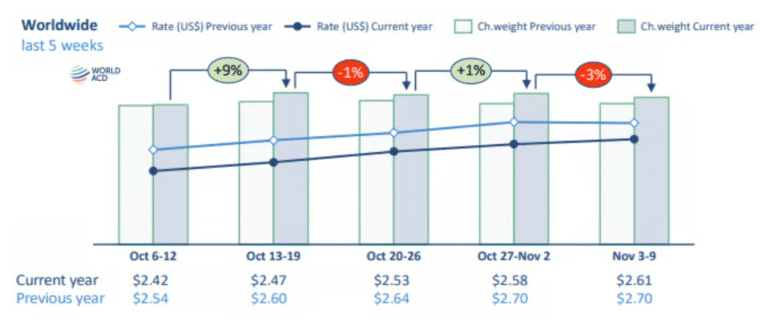- In week 45 (3–9 November), air cargo spot rates from Asia Pacific increased by 2 percent, lifting global averages slightly, despite a 3 percent drop in worldwide tonnages. Regional holidays and typhoon disruptions affected volumes in Asia, while US operations saw minimal disruption despite FAA grounding of MD-11Fs. Spot rates from Central & South America rose the most, up 8 percent.
- YoY, total global volumes are up 6 percent, while rates remain 4 percent lower, reflecting tough comparisons with a high-demand 2024. Asia Pacific to US volumes dipped WoW but remained slightly higher YoY, with Southeast Asia outperforming Northeast Asia. Asia-Europe rates also rose 2 percent WoW, with China-origin prices increasing 5 percent.
Air cargo spot rates from Asia Pacific origins continued to increase in the first full week of November, slightly raising average rates and spot rates globally, despite a week-on-week (WoW) fall in global tonnages.
The charts in the PDF report contain the latest insights on air cargo market developments, covering the last five weeks up to Sunday, 9 November 2025.
According to the latest figures from WorldACD Market Data, spot rates from Asia Pacific origins edged up by a further 2 percent WoW in week 45 (3 to 9 November) to US$3.99 per kilo, nudging global spot rates upwards by 1 percent to $2.78 per kilo. The most significant WoW increase in spot rates was recorded from Central & South America (CSA) origins, up 8 percent to $1.87.
Meanwhile, total worldwide tonnages slipped by 3 percent WoW, with chargeable weight falling 3 percent from Asia Pacific, North America, and CSA origins, and by 2 percent from the Middle East & South Asia (MESA) and Africa. Tonnages from Europe declined by 1 percent WoW.
The drop in volumes from Asia Pacific was partly driven by national holidays in Japan and, to a lesser extent, Malaysia. Japan’s outbound tonnage fell 11 percent WoW, pulling down the region’s overall volumes by 1 percentage point. Other factors such as Typhoon Kalmaegi also played a role, though its impact was mainly confined to the Philippines in week 45.
In the United States, flight cancellations caused by the partial Federal government shutdown were largely limited to domestic services. Additionally, the FAA grounded MD-11 freighters on 8 November, near the end of week 45, though some operators had already suspended flights after the UPS MD-11F crash on 4 November in Louisville, Kentucky.
Globally, air cargo capacity remained stable in week 45. A two-week-on-two-week (2Wo2W) comparison showed a 1 percent decline in capacity between weeks 44–45 versus weeks 42–43. This slight reduction in passenger bellyhold capacity following the end of the summer schedule on 25 October was largely offset by increased freighter availability.
Trends Align with 2024 Patterns
This year’s patterns in week 45 broadly mirror those of 2024, especially when averaging across weeks 44 and 45: tonnages are relatively steady but trending slightly downward, while rates are climbing ahead of peak-season events such as Black Friday, Thanksgiving, and Christmas. However, in absolute terms, average worldwide tonnages for those two weeks are 6 percent higher year on year (YoY), while average rates are 4 percent lower YoY.
It is worth noting that rates during this period in 2024 were unusually elevated compared with 2023. In week 45 of last year, full-market rates had risen 12 percent YoY and spot rates stood 23 percent higher than in 2023, driven by a surge in e-commerce volumes from China and a significant capacity squeeze. Current rates therefore face tough YoY comparisons but remain high by historical standards.
In the Asia Pacific market, spot rate trends in weeks 42–45 this year were similar to last year’s: average spot prices rose by $0.26 per kilo this year, compared to $0.29 in the same period last year. However, the absolute figure of $3.99 per kilo in week 45 is 7 percent lower than the $4.30 recorded in 2024.
Asia Pacific–US Market Falls
Asia Pacific to US volumes declined 6 percent WoW in week 45, with almost all origin markets showing lower volumes, except Singapore and Indonesia. China, Hong Kong, and South Korea each recorded a 6–7 percent decline WoW. Compared to the same week last year, overall volumes were up 2 percent, driven by Southeast Asia (up 30–50 percent), while Northeast Asia trailed behind (mainland China down 9 percent, Hong Kong down 14 percent, and South Korea down 18 percent YoY).
Spot rates on Asia Pacific–US routes were flat WoW, with Japan notably down 21 percent, likely due to the national holiday. YoY, average spot rates for this corridor stood at $5.39 per kilo, 15 percent lower than last year. All top ten origin markets in the region posted double-digit YoY declines in spot rates to the US, except China, which saw a 9 percent drop to $5.57 per kilo.
Asia Pacific–Europe Market Trends
Asia Pacific to Europe volumes fell 2 percent WoW in week 45, partly due to holidays in Japan and Malaysia. Volumes from China and Hong Kong remained flat. Compared to the previous year, Asia Pacific to Europe volumes were up 9 percent, though this marked a slight deceleration from the previous three weeks’ double-digit YoY growth.
On the pricing side, spot rates from Asia Pacific to Europe rose 2 percent WoW to $4.20 per kilo, with China-origin rates up 5 percent WoW to $4.56. Compared to last year, spot rates from the broader Asia Pacific region to Europe in week 45 were 10 percent lower, while China-to-Europe rates were 6 percent higher YoY.




